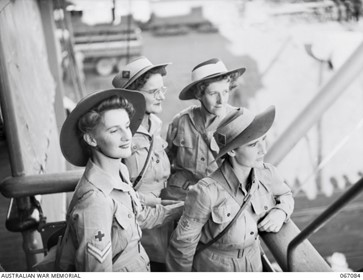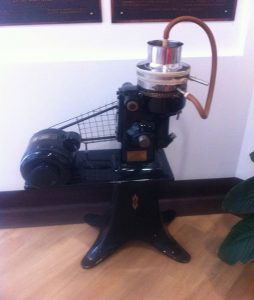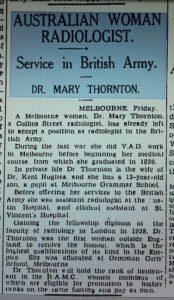World War II
“Fellow Australians, it is my melancholy duty to inform you officially, that in consequence of a persistence by Germany in her invasion of Poland, Great Britain has declared war upon her and that, as a result, Australia is also at war. No harder task can fall to the lot of a democratic leader than to make such an announcement.”
The sombre words of Australian Prime Minister, Robert Menzies, broadcast to the nation
3rd September 1939
With those words, any lingering delusions that the fragile peace would hold were singularly extinguished. Australia was again a country at war.
Once again, Australian military forces were mobilized in the interests of the Empire and the nation and, once again, Australian medical women would play their part.
It was in 1940 that the first Australian woman doctor, Major (Lady) Winifred Mackenzie was commissioned into the Australian Army.
Over the duration of the war, other women served as doctors, medical researchers, pathology technicians, dieticians and physiotherapists.
World War II would be a period when medical women found greater professional legitimacy in their army roles. Paradoxically they participated less overseas, undertaking more significant ‘home guard’ roles, establishing a foundation for the future role of women in the Royal Australian Army Medical Corps (RAAMC).
Despite this, some women (such as Major Mary Thornton) did serve overseas with our allies. Army physiotherapists served abord hospital ships and in the Middle East and members of the AAMWS saw service in New Guinea and Bougainville.
Following the war, pharmacist Lieutenant Elizabeth Wunsch and at least one female army doctor, Major Elsie Abrahams served as part of the British Commonwealth Occupation Force (BCOF) at 130 Australian General Hospital at Eta Jima, Japan

Australian Army Medical Women’s Service (AAMWS) members of the 2/1st General Hospital waiting to disembark from the HMT Ormiston at Townsville in June 1944 on their arrival from New Guinea. Australian War Memorial Accession number 067084 (copyright expired: public domain)
The formation of the Australian Women’s Army Service (AWAS) was authorised by the government on 13 August 1941 to “release men from certain military duties for employment in fighting units.” The AWAS was the only non-medical women’s service to send personnel overseas during the war; in 1944 and 1945 AWAS served in both Dutch and Australian New Guinea. By 30 June 1947 all members of the AWAS had been demobilised.
Lieutenant Jean Kahan and the Alpha Laval cream separator she brought to Perth during World War II to provide blood transfusion services at Hollywood Hospital
“The centrifuge used [to separate the plasma from the blood cells] was a cream separator, driven by turning a handle as farmer’s wives has always done. When we were centrifuging blood, the cells were ejected at the ‘cream’ spout and the ‘plasma’ at the ‘milk’ spout.”
Kahan, Jean. The Cream Separator and the bleeding room, self-published, 2006



L Cpl Kath Walker enlisted into the Australian Women’s Army Service (AWAS) on 5 December 1942. Image courtesy of Australian War Memorial. Copyright expired. Public domain.
She later changed her name to Oodgeroo Noonuccal became a well-known indigenous poet, actress, writer, teacher, artist and campaigner for Aboriginal rights
Melbourne newspaper announcing service of Major Mary Thornton (nee Kent-Hughes) and a painting of her tin hat emblazoned with ‘Keep your tail up’ sourced from her autobiography



“For the thousandth time did I curse the Australian military authorities whose refusal to accept service from a woman doctor had forced me across the world.”
Mary Kent-Hughes (nee Thornton) in Matilda waltzes with the Tommies Melbourne, Oxford University Press 1943
Pictured: Recruiting poster for the Women’s Army Corps.
References for further WWII reading and research
- Walker, Allan S, Australia in the War of 1939-45: Medical, Middle East and Far East, Australian War Memorial, 1953
- Kent-Hughes M, Matilda waltzes the Tommies, Oxford University Press, 1943
- Ford E, Mabel Josephine Mackerras, Medical Journal of Australia, 1972 No 1.
- Sweeney AW, Malaria frontline. Australian Army research during World War II. Melbourne University Publishing, 2003
- Adams-Smith, Patsy, Australian Women at War
- Williams L, No Man’s Land: A History of the 2nd Australian Women’s Hospital, 1997
Share Your Story
We have barely scratched the surface when it comes to Australian women at war, and would love to hear your stories and have them appear on our website.
Please fill out the form so that we can get in touch with you.
NOTE: If you are trying to research a family member, please start with the War Memorial in Canberra or your state or territory. This form is only for helping us to share your stories.